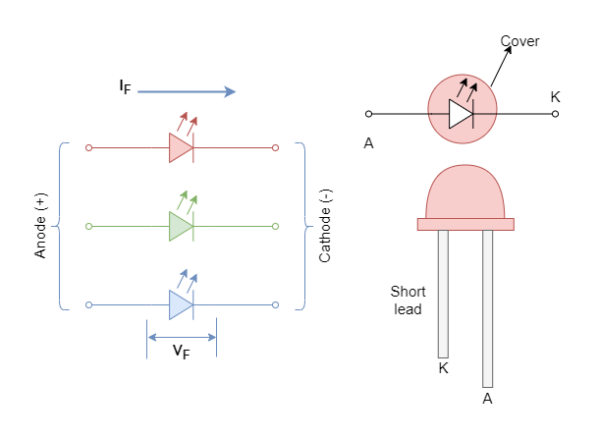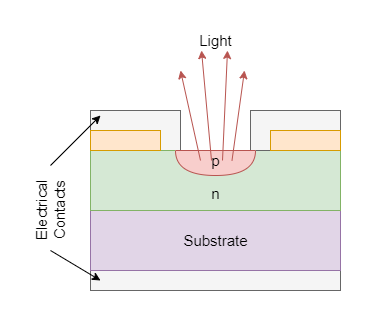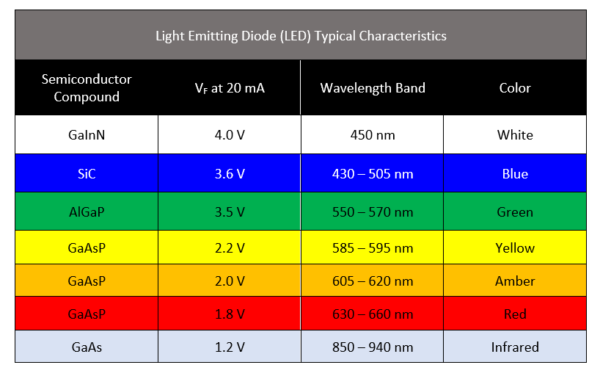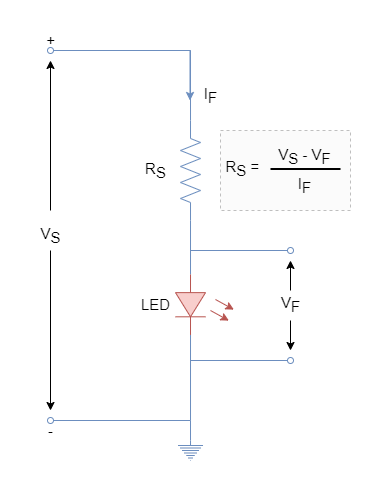LED is a device that converts electrical energy into light energy and is a current-driven semiconductor device. The emitted light can be in the visible or invisible spectrum. LEDs can be classified as the most widely used semiconductor devices, mainly used in color displays, televisions and street lights. LEDs are fabricated with thin layers of heavily doped semiconductor material. Different semiconductor materials and doping levels emit light at different wavelengths. Light emitted in the form of photons is the energy released when conduction electrons recombine with valence band holes. While recombining, enough energy is released to produce monochromatic light via photons.
Physical building
LEDs differ in physical appearance and construction from traditional diodes. Usually, the PN junction of the LED is covered by a hemispherical high-strength transparent epoxy. This structure not only helps protect the delicate structure of the LED, but also acts as a lens to concentrate/focus the emitted light. The light emitted by the PN junction is not strong and will be reflected inconspicuously. However, the dome-shaped construction helps the light to focus, intensify and stand out more. LEDs with monochromatic light have two legs, an anode (+) and a cathode (-). The LED's cathode can be identified by a flat surface/notch or a short lead. LEDs are replacing traditional light bulbs due to their efficiency and size. While traditional light sources dissipate heat and lose a lot of energy, LEDs do not heat up, resulting in minimal voltage drop across them. As an electrostatic device, LEDs can be made in very small sizes and shapes depending on application requirements.

LED Symbols and Typical Shapes
Composition of LEDs
The composition of the PN junction is selected by color or by emitting a specific wavelength. The semiconductor materials used in traditional diodes are silicon and germanium, while the semiconductor compounds used in LEDs are gallium phosphide (GaP), silicon carbide (SiC), gallium arsenide phosphide (GaAsP), gallium arsenide (GaAs) or Indium Gallium Nitride (GaInN), etc. These compound semiconductors are made by mixing semiconductors in a certain ratio/mixture to enhance specific wavelengths.

LED combination layer
Different compounds and mixing ratios produce light in specific bandwidths of the spectrum and characterize the intensity of the emitted light.

From the above diagram, it is clear which semiconductor compound and its wavelength will emit what color. The housing of the LED is usually made of the color that belongs to the light emitted by the PN junction. It is only used to indicate the color of the LED, in addition, it can also enhance the output of the emitted light. The most common and cheapest colors are the three optical primary colors, red, green, and blue, which are easily produced by semiconductor compounds. Other colors are expensive and are produced by mixing primary colors.
Types of LEDs
Gallium Arsenide (GaAs): Infrared
Gallium Arsenide Phosphide (GaAsP): Red, Infrared, and Orange
Aluminum Arsenide Phosphide (AlGaAsP): Red (bright), orange, and yellow
Gallium Arsenide (GaP): Red, Yellow, and Green
Aluminum Gallium Phosphide (AlGaP): Green
Gallium Nitride (GaN): Emerald Green
Indium Gallium Nitride (GaInN): Ultraviolet, Green (Blue) and Blue
Silicon Carbide (SiC): Blue (Substrate)
Zinc selenide (ZnSe): blue
Aluminum Gallium Nitride (AlGaN): UV
Voltage drop and series resistance
Like traditional diodes, LEDs are current driven and experience a voltage drop when placed in forward bias mode. For the type of compound used in the LED, the forward voltage drop (V F ) ranges from 1.2V to 4.0V. LEDs emit light when a voltage greater than the forward voltage drop is applied and current flows. Excessive current can damage the sensitive PN junction of the LED, so an appropriate series resistor needs to be inserted between the LED and the voltage source. The value of the series resistor should not exceed 80% of the rated current of the LED and should allow enough current to significantly light the LED.

A single LED in series with a resistor
Indicated use.
Seven-segment display for displaying numbered data.
Handheld devices, flat-screen LED TVs, and large-screen displays for advertising.
Infrared powered devices such as remote controls.
Optocoupler.
In conclusion
Light-emitting diodes convert electrical energy into light energy.
A light-emitting diode is a special type of diode whose PN junction is made of compound semiconductors.
LEDs consist of heavily doped semiconductors with very thin PN junction layers.
A forward biased LED enables electrons in the conduction band to recombine with holes in the valence band. In doing so, the electrons release energy in the form of photons/light.
The color of the photon emission depends on the semiconductor compound used in the LED, and its intensity depends on the forward bias current.
The wavelengths of the emitted colors lie in the visible or invisible spectrum.
The series resistor is mainly used to avoid damage to the LED, the value of the series resistor needs to be calculated according to the LED type, the number of LEDs and their series/parallel configuration.
LEDs are available in a variety of colors. Monochrome is widely used and cheap. Bicolor and multicolor LEDs are also available, but at a relatively high cost.
LED applications include, but are not limited to, indication purposes, monitors, televisions, and large advertising displays, among others.
Please feel free to contact us via BOM!



























